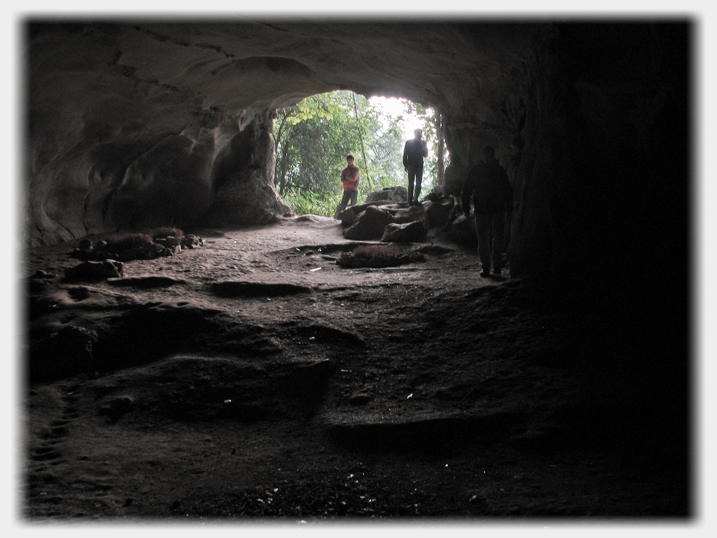
|
The Cave Allegory
Living in darkness its hard to make out objects in the light. And (apart maybe from the boots at centre right) we cannot see well what is near us. Maybe a fire lit in the cave would reveal other objects, but in a flickering light these might appear, from our perspective, as distorted phantoms. This story was made famous by Plato. (The Republic) It sets up a contrast suggesting that just as people who only lived in a cave might find the outside world brighter, sharper, richer, so we in turn in that outside world are only experiencing a poor dim image of what is really the case. The real world for Plato is truer in all senses and ways than this one in which we live. Here, in normal life, we only have hints of that richer world, dim reflections, poor substitutes for the treasures with which we do not at present live.
The strength of the analogy is the way it shows us why abstract terms such as truth, beauty and good have such power, and are not mere common denominators of what is around us. It raises our hope of there being more to life than we normally see, and lets us expect fuller explanations of problems otherwise elusive. Both Plato's idea and the idea of a god work like this, they offer us something beyond experience which can explain experience. If we use the metaphor of 'world', with all its pitfalls, we could say that Plato is suggesting two worlds, the daily one of our experience, and another that is in some sense elsewhere (at least not easily available to us) but of which we may once have been part. Between these two worlds there are links that mean the daily world can remind us of the hidden world much in the way that memory reminds us of past events. These 'reminders' raise in us ideals of such matters as beauty and truth. So the structure is of two worlds one of which can call up the other and so gain crucial enhancements.
There is a modern variation on Plato's account which comes from writing in neuropsychology. Gray's (Gray, 2004) comparator model has a similar and parallel structure. Two worlds are connected by sensations: the world as it is independently of humans, and the world of our mental lives–of consciousness. All our experiences–our mental activities–belong to the latter, and are built in response to the former, and the 'function' of consciousness is to create a model which then guides our actions in that other and independent world. In building our mental worlds we use abstractions from the (relative) particulars of sensation, and in turn build abstractions on the abstractions. The resulting concepts are global in form–concepts such as truth and beauty which are triggered by the particulars of a sunset, a body, a pattern of observations, an act of kindness.
The third pillar to the edifice of our photographic collections is far from private. We explicitly snap what we see when travelling in order to show other people. The growth in photography has been exactly matched by the growth in mass tourism. We visit places novel to us and collect samples into our small black boxes to return, so often vainly, anticipating examination of our specimens with our friends. We seek out townscapes, we seek out landscapes, we seek out novelty, we seek out nature benign and nature raw, to add to our collections. We travel with our cameras for the afternoon, the weekend, or round the world, clicking away - and so tourism, from early days, made the fortunes of photographic manufacturers.
So again for writers such as Gray the structure is of two worlds one of which can call up the other. But now the calling comes through the medium of sensation (sensation which is utterly entwined with memory) from the outside, and what is called to, is within us. Now wonder comes on the back of particulars which dimly 'remind' us of that greater world within which consciousness is but a small part, and from which emerge the objects that become part of consciousness. To this process attention is the midwife. Both writers see light outside our cave and begin to explain the wonder we find in our cave, its meaning, and the yearning we feel, as a veiled longing for what is out there, beyond this world.
References
- Plato 'The Republic' [For example Translated] Shorey, Paul (1930) in Loeb Classics.
- Gray, Jeffrey (2004) Consciousness: creeping up on the hard problem. OUP
15th October 2015 ~ 19th October 2015